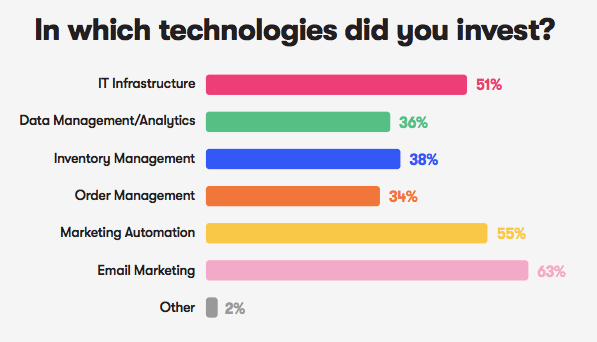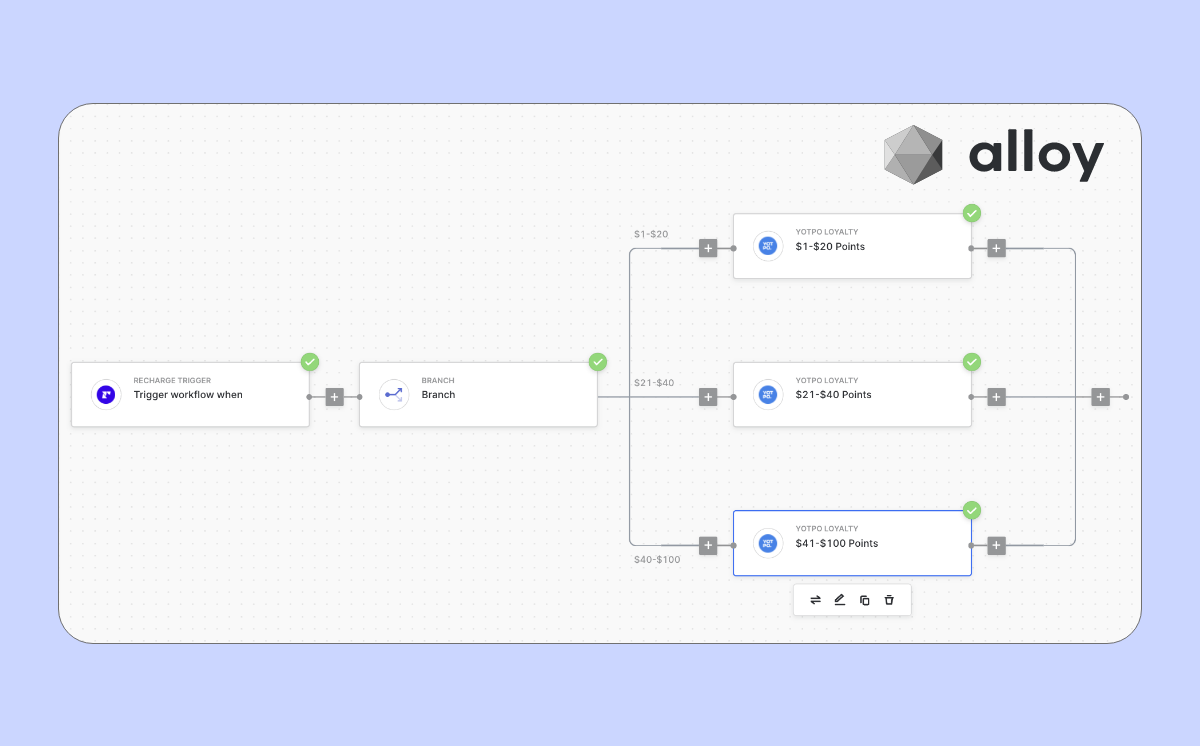Growing your eCommerce store is both exciting and overwhelming.
eCommerce automation gives you and your team space to focus on creative and thought-provoking tasks.
This article will cover the benefits of eCommerce automation, as well as six ways to automate your eCommerce store (with examples!).
Let’s get into it.
What is eCommerce automation?
eCommerce automation is software built to turn tasks, processes, or campaigns throughout your business into automations that execute precisely when needed; which saves you and your team the most important asset: time.
When you automate mindless tasks, like data entry, shipping and handling, and sending emails, you’re expanding your entire teams’ horizons—everyone can focus on more thought-intensive tasks!
Business owners are catching up to the hype. Last year, 46% of eCommerce businesses spent 40% more on technology tools.

Download our latest State of eCommerce report
You’ve probably invested in some automation tools yourself. Think Google Analytics, Slack, and Zapier.
The best part is that you can automate your business in all areas, including:
- Marketing (email marketing, social media marketing, content marketing)
- Inventory
- Order fulfillment
- Data analytics
- Project management
- Customer service
- Accounting and invoicing
But hey, you don’t have to take our word for it. Let’s dive into the top eCommerce automation benefits backed up by your fellow online business owners.
Benefits of eCommerce automation
Automation is primarily known for outsourcing mundane tasks—sending invoices, entering data, printing shipping labels—are you yawning, too?
What’s great about outsourcing tedious tasks is the time you gain. 66% of small business workers agree that automation opens the door to more creative projects, like community building and envisioning future products.
And the added cherry on top? Automation will scale alongside your growing business.
Take Amy Wall, the CEO of Skintessa.

Using Sendlane, Amy automated her skincare brand’s email marketing efforts and loved its intuitive platform and customer support.
She exclaims, “Recently, I did one email campaign that made over $3,500! As a small business with a growing audience, every win builds momentum and Sendlane has been a big help there.”
When you get big results like Amy, you’re able to compete with the big guys. 88% of small businesses think automation helps them compete with large companies.
Overall, online stores have improved in all areas of their business, thanks to automation. We’ve seen businesses expedite their customer support system, data tracking, and overall productivity.
But let’s turn the conversation back to you and figure out how you can streamline your workflow, team, and tasks.
//[inject:ad-multi-store]
6 Ways to Automate Your Online Store
You can streamline your business using these six automation essentials.
1. Streamline your operations management
Ordering, storing, and delivering your items can amount to one giant headache. In hindsight, many companies wished they had set up an operations automation workflow prior to Covid-19.

Investing in an operations automation system can result in:
- Faster delivery and shipping: This is essential when you’re up against Amazon’s up-and-coming same-day delivery
- Decreased stock-outs: Going out of a stock directs customers to your competitors—not good!
- Less chance of theft and loss: In our recent eCommerce report, we found that 16% of eCommerce businesses are most concerned about fraud
If you don’t know where to start with operations automation, focus on two of your most important tasks—ordering and shipping.
In the ordering department, you can:
- Update stock automatically
- Set up notifications when your stock changes
- Sync customer information with your inventory management system (Unless you use dropshipping, which we’ll explain soon!)
- Send order information to customers once they pay
As for shipping items, you might want to look into dropshipping. Dropshipping ships orders directly from the manufacturer to your customer, completely eliminating your inventory management system.
Many eCommerce businesses find success with dropshipping. Haroon Naseer, the owner of a drop shipping company, shares how “Dropshipping has significantly made retail eCommerce more effective and efficient.”
With shipping and ordering covered, you may be looking for the best eCommerce automation tool to handle operations. Interestingly enough, many small businesses use project management tools to organize their processes.
In this Small Business Automation Report, Ashutosh Cheulkar shares how businesses will “map their entire order fulfillment process in project management tools like Trello or Asana.”

Kellie uses Trello to organize her Etsy shop’s inventory and shipping
Then, he explains, they will “use automation to pull in data from their eCommerce platform to create tasks in the specific stage with all the relevant details and assign it to the designated team.”
Overall, project management helps you manage every touchpoint post-purchase.
Focusing on operations will not only benefit you but your customers. Stocked items and on-time delivery will boost your customer experience, especially when you pair them with customer segmentation.
2. Customize with customer segmentation
Inaccurate advertisements and spammy emails are a thing of the past. With customer segmentation, you can target your audience with relevant ads, emails, and social media posts, and even personalize the on-site experience.
There are many ways to segment your customers, including:
- Demographics: Age, gender, occupation, etc.
- Geographics: Location and time
- Psychographics: Personality, attitude, value, and interests
- Technographic: Mobile usage, website usage, apps
- Buyer behavior: Customer lifetime value, purchase history
With segmentation in place, you can send customized emails, promotions, and advertisements.

The Banana Republic, for example, sends its reward members personalized emails and discounts.
Of course, you’ll have to collect this information before reaping the benefits of customer segmentation.
There are two ways to automatically collect your customer’s information: Third-party tools and first-party data.
Third-party tools are any customer information you collect from outside sources, like Sendlane’s website tracking tool.
But this year’s eCommerce marketing trends report found that third-party cookies are harder to collect, thanks to Apple’s strict privacy rules.
This is where first-party data comes in. First-party data accounts for data your customers willingly give to you, like surveys, quizzes, and community groups!
Once you have all this juicy data, you’ll need software to compile your information into segmented lists.
Some of the best eCommerce automation tools for segmentation are Shopify, HubSpot, and of course, Sendlane! Using our Justuno integration, you can provide hyper-personalized pop-ups, emails, and text messages to each individual customer.
This is your opportunity to automate the necessities, like customer data collection, targeted ads, and the famous abandoned cart email.
3. Recover abandoned carts
Abandoned cart emails are all the talk, but how necessary are they, really?
According to the statistics, abandoned cart recovery is pretty dang essential. In March 2021, almost 80% of online shopping orders were abandoned!

We know you don’t have time to single-handedly send individual abandoned cart emails. Instead, opt for email marketing automation.

Pepper offers incentives to users to come back to their cart with a $5 discount. With automation, you can identify each individual buyer’s favorite incentives and attach them to their abandoned cart email!
But emails aren’t the only way to decrease cart abandonment. Give your marketing strategy a spin and try SMS messaging.

WodBottom takes advantage of the SMS’ notable short-response times and delivers cart reminders via text. An image, small word count, and a shortened link should do the trick.
As for the best eCommerce automation tool for abandoned carts, we can’t help but recommend Sendlane. With our platform, you can send dynamic abandoned cart emails and start recovering otherwise lost sales on autopilot.

You can set up your funnel to include a mix of email and SMS to reach your customers where they’re most active. Easy peasy!
But abandoned carts aren’t the only part of email marketing you should automate…
4. Personalize your email & SMS marketing automation
Nowadays, you can send hyper-personalized emails without lifting a finger–thanks to email marketing automation.
After switching to Sendlane, LifeBoost Coffee’s email deliverability increased by 39%! Dr. Charles Livingston, the CEO of LifeBoost, shares, “One of the emails we sent generated $30k alone, other campaigns can easily bring in $10k-$15k each time, and our revenue per contact has increased to almost $83.”
All of this success from eCommerce automation? Sign us up!
As a bonus, use your automated customer segmentation system to send personalized emails throughout the customer journey.
One example is a product recommendation email. Sephora gives this strategy a twist with a “Back in Stock” email.

With an operations automation strategy in place, it’s easy to notify your customers when certain items are back on the market!
And you can’t forget about these other customer retention emails & SMS:
- Sales and promotions: Use deep data integration to identify your customers’ favorite promos.
- Thank you emails: Did someone buy a product? Send them a big “Thank you!” and a freebie, like a 10% off discount on their next order.
- Product reviews: Request a review, post-purchase, and generate it to your site
If you’re going to apply eCommerce automation to anything, go for your email marketing system. A solid email strategy can nurture your audience from the moment they visit your store to post-purchase.
5. Build your post-purchase plan
As you grow your eCommerce business, your sales focus might default to attracting as many new customers as you can.
Customer acquisition is vital, but what about the customers who already bought from you? With a post-purchase automation system in place, you’ll keep customers from exploring your competitors.
Customer retention can be as simple as sending a product review email.

Take BLUBox’s advice and wrap your product review request into a “Thank you for your purchase!” email. Even better, reward anyone who sends back a review with a discount or freebie.
And you can’t forget about reminding your subscription users to restock their items.

Subscriptions skyrocketed amidst the pandemic and are in for the long haul. In a report about the long-lasting effects of COVID-19, 23% of respondents felt they were likely to continue buying subscription services.
If you’re just hopping on the subscription service train, encourage users to join with a “Time to refill your product” email.

Chewy gathers their customers’ past purchase history and reminds those buyers to refill their orders. Think of it as a simple nudge to repurchase items you’ve liked in the past.
Post-purchase emails only work if they’re targeting the right person. With an eCommerce automation tool like Sendlane, you can apply their deep-data integration tool and send these emails based on their purchase history, clicks, opens, and reads.
See how helpful a robust email marketing automation workflow can be? We could rave about email marketing forever. But there’s another type of eCommerce automation that you should know about – social media posting.
6. Engage your social media
Get this: Internet users spend nearly two and a half hours a day on almost seven different social platforms.
The mere thought of posting across seven different platforms sounds exhausting in and of itself. You not only have to create and post, but you also need to engage with your followers through live videos, reposts, and comments.
Good thing you’ve got eCommerce automation to help you out. An efficient social media tool can help you:
- Sell products through social channels: By 2025, social commerce is predicted to account for 5.2% of eCommerce sales
- Build brand awareness: Social media is an invitation to share your mission, humor, and even your personal life with your followers. These types of posts build trust with your followers.
- Schedule posts: Save the scheduling for an automation tool and use your time to create your posts
Now for the real question—what type of social media posts increase brand awareness and revenue?
Let’s start with positive testimonials.

Amma periodically posts photos of their happy customers using their product on Instagram. Picture-perfect models are no longer on the advertising agenda. Your customers want to see normal people using your products!
You can either ask past buyers for submissions or repost user-generated content on your feed and story.

User-generated content is amazing because customers can see how your product works on other people AND it’s free!
Social media is also an amazing platform to educate your audience about your brand.

Modern+chic rewards its followers with sneak peeks at its products and special promotions. High-resolution camera equipment is no longer needed. A smartphone, an enthusiastic personality, and quality content are all you need to build connections.
Of course, these brands can’t execute a polished social media strategy without automation. Here are the best eCommerce automation tools for social media:
- Scheduling: Buffer or Hootsuite to schedule posts and monitor your engagement
- Design: Free tools like Canva can help you design posts and will even schedule straight from their platform.
Social media doesn’t have to feel draining. Outsource the nitty-gritty with eCommerce automation and use your time to create brand-aligned content.
eCommerce automation is here to stay
As amazing as eCommerce automation is, getting started can feel overwhelming. How do you start, and which software do you choose?
If you don’t know what to automate first, take the next two weeks and observe tasks that bog down you or your team. Then, look into the right software to take those tasks off your hands! The onboarding process can take time, but the results are worth it.
And if you find yourself needing marketing automation, why not take Sendlane for a spin? We're an email & SMS marketing automation platform built to help eCommerce stores (like yours) save time and generate more money on autopilot.
Try us out for 60-days and get in touch with our savvy support team!

%20(1).png)




%20(1).png)
.jpg)


.jpg)
.jpg)


.jpg)





.png)



.png)





.png)


.png)

.png)
.png)

.png)
.png)

.png)

.png)


.png)
.png)
%20(1).png)
.png)









.png)











.png)
.png)

%20(1).png)

%20(1).png)



.png)


























.png)











































.jpeg)



.png)



























.png)



.png)

.png)

.png)
.jpeg)


.png)













.png)

.png)










.png)












.png)






































.png)



.png)

.png)

.png)
.png)

.png)
.png)

.png)

.png)

.png)




.png)




















